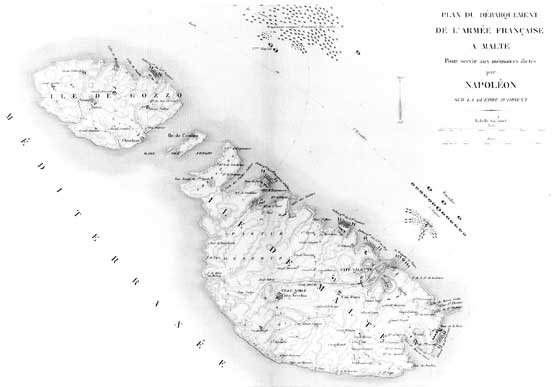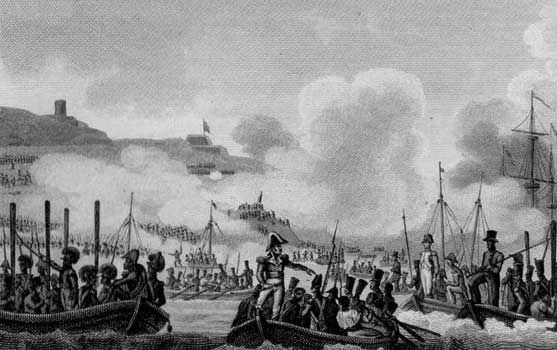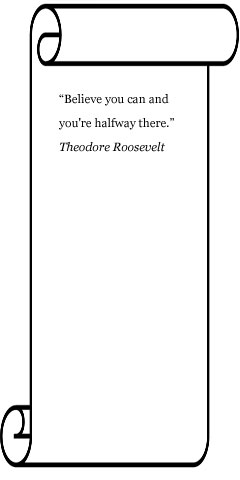| Napoleonic Malta
By Mike Bennighof, Ph.D.
April 2012
When the French fleet hove to off Malta on 9 June 1798, the Knights of St. John who ruled the islands refused to grant the French harbor privileges. Grand Master Ferdinand von Hompesch had done next to nothing to prepare the Order's fortresses for war, and when Napoleon landed troops the next days and made ready to assault the Maltese capital the Knights quickly capitulated.
Napoleon had made the suggestion to seize Malta during the early planning stages of the expedition to Egypt, and the Directory approved and included the instruction in his formal orders issued in April. Someone leaked this instruction to Hompesch, who the French suspected of sympathy with the Austrians after spending 25 years as the Order's ambassador to the Habsburg court in Vienna. Knowing Hompesch's desire for a comfortable retirement, the Directory noted that he might turn the island over to the Austrians and give them an unwanted foothold in the central Mediterranean.
France's revolutionaries also held a serious grudge against the Knights. The Order had helped finance the attempted flight of King Louis XVI in June 1791 that ended with his capture at Varennes; when the king lost his head to the guillotine, the Order held solemn services in the cathedral but also allowed the British to recruit Maltese workers and sailors for their occupation of Toulon. The loss of the French King also deprived the order of much of its property and income, and the Knights turned to Tsar Paul I of Russia, naming him Protector of the Order in January 1797. Bonaparte's agents intercepted the correspondence and gleefully published it, embarrassing both the Order and the Tsar. Taking the island would therefore settle a political score as well as giving France a piece of vital strategic ground.

Napoleon's plan for the landing on Malta, June 1798.
To prepare the way, the French infiltrated two agents onto the island, one of them a Maltese volunteer and the other Mathius Poussielgue, the chief financial officer of Napoleon's former command, the Army of Italy. Poussielgue made no secret of his visit, spending four months drinking and dining with the Knights including his cousin, the Guardian of the Port of Valletta. On his return in March he reported the Knights disaffected and degenerate; most of them were French and several leading figures, including the Treasurer and the Commissioner of Fortifications, had strong sympathies for the French Republic. If suitably bribed the Knights would not fight, but they would defend the island if attacked.
In addition to 362 Knights (260 of them Frenchmen of dubious loyalty), the Order mustered ground forces known as the "Congregation of War." Grand Master Emmanuel de Rohan-Polduc, Grand Master from 1775 until his death in July 1797, had tried to build a modern if small professional army for the Knights. Built mostly from long-service Maltese conscripts and officered by Knights and European mercenaries, the Congregation forces were modeled on the French pattern. These included a regular infantry regiment, a guard battalion, two battalions of marines (one each for sailing ships and galleys), a small cavalry regiment and a number of artillery companies. The Maltese militia provided a full-time regiment of volunteer light infantry, and 11 regiments and one battalion of very loosely organized and poorly armed militiamen. All told Maltese regular forces numbered about 7,000 including ships' crews.
The Order's Navy built its ships at the Seneglea shipyard on Malta, noted for good quality work (Maltese shipwrights were highly sought around the Mediterranean basin). Most of the fleet had been sold to the Kingdom of Naples in 1781. In 1798 the Knights had two 64-gun ships of the line, San Zacharia and San Giovanni, a 40-gun frigate named Santa Elizabetta and the 36-gun Santa Maria del Pinar. San Zacharia and Santa Maria del Pinar were approaching 40 years old and apparently suited for no more arduous duty than harbor service. There were also four war galleys on hand. None of the ships were fitted out for service, and the Knights do not appear capable of mustering a full crew for any of the larger warships had they somehow found the will.
While Rohan brought the Knights' regular forces into the 18th century, he continued the ruinous practice of former Grand Masters and spent huge sums on new fortifications. Under his watch the Knights built the modern Fort Tigne and replaced St. Lucian's Tower with the state of the art Fort Rohan. By 1798, successive Grand Masters had built up the area around Grand Harbor into a massive citadel that Napoleon estimated would require a garrison of 15,000 regulars — more than twice what the Knights could muster.
Hompesch, Rohan's successor, made few defensive preparations other than to lay in four months' worth of supplies. When the first French ships appeared on 6 June 1798, he allowed one to enter Grand Harbor for repairs. When the bulk of Napoleon's fleet appeared three days later, Hompesch refused entry, allowing only four ships to enter the harbor and take on fresh water. The Corsican general replied with a stern letter, and began landing troops as soon as night fell. The French marched on the fortifications the next morning, expecting no resistance.

The French land on Malta, 10 June 1798.
"The Maltese prepared to defend themselves," recalled Capt. Joseph-Marie Moiret of the "Invincible" 75th Demi-Brigade, "and rained down bombs, bullets and grape-shot on us. The hailstorm did not surprise or dampen the enthusiasm of our soldiers who, protected by the ships' gunboats, leapt into the fortifications and slew or took prisoner all who opposed them."
The Cacciatori Maltesi, the volunteer light infantry, did put up a fight to hold Fort Tigne against Moiret's 75th, though apparently more stoutly than the captain claimed as they drove off the first two attacks. The French suffered three killed, and by noon most resistance had ceased except at Fort Rohan, where the regular regiment held out until noon the following day. The Maltese showed much more willingness to fight than the Knuights, and two different militia regiments stood Knights up against convenient walls and shot them for cowardice under fire. Though abandoned by their officers, the Maltese refused to lay down their arms until Bonaparte promised the island's priests that there would be no effort to suppress the Roman Catholic faith.
Re-assured about their religion, the Maltese quickly turned on the hated Knights. The English consul reported that the Order's fall at first had wide popularity among the islanders, and Napoleon would be able to enlist 300 of the regulars in his own Legion Maltaise, which went with him for Egypt. While his troops deserted in droves, Hompesch called a council of war, only to have his Treasurer inform him that he would not fight against his French countrymen. Hompesch had him arrested but issued no other orders other than to send an emissary to Bonaparte offering the Order's surrender.
Negotiations went quickly, and by nightfall on the 11th a treaty was ready. The Order handed sovereignty of Malta to the French Republic, and in exchange Hompesch would receive an annual pension of 300,000 francs with much smaller pensions for the other Knights depending on their age. In addition, the French would use their good offices to obtain a principality in Germany for Hompesch, at least equivalent in size and population to Malta. Hompesch would never collect his new realm or much of his pension, and he died in French exile six years later.
During his six days on the island, Napoleon began a seeming whirlwind of activity, though most steps had been prepared in advance. Hompesch and all the politically unreliable former Knights were deported to Trieste as a useless gift to the Austrians, who Napoleon knew would feel obligated to tolerate their useless (and expensive) presence. The conqueror allowed them to take their splinter of the True Cross and hand of John the Baptist (patron saint of their order), though he made them remove it from its jewel-encrusted reliquary.
Seventeen Knights who had aided the invaders were allowed to accompany Napoleon to Egypt as honored guests; 34 other French Knights of military age were ordered to volunteer for the rank-and-file of his army. No Knights under the age of 60 would remain on the island. Napoleon issued a new constitution that made Malta a department of the French Republic, with power residing with a nine-member commission made up of eight Maltese and one French scientist. Slavery was abolished, and 2,000 Muslim slaves liberated — this proved highly unpopular with the Maltese and for their own safety the newly-freed men were enlisted in the French ships' crews. A new school system on the French model was established, with sixty boys selected for education in Paris. The Maltese militia was re-formed into two National Guard battalions on the French pattern, a new bureaucracy including a postal system and civil marriage decreed, and the number of monasteries and seminary students reduced while all non-Maltese clergy (including monks and nuns) were expelled.
All weapons, artillery and ammunition were confiscated, including 1,000 cannon and 35,000 muskets, though most of the powder proved rotten. The ships of the line San Zacharia and San Giovanni were incorporated into the French fleet as Dégo and Athénien, but neither left Malta. Of the two frigates, the old 36-gun Santa Maria del Pinar received the new French name of Berouse, but would be broken up for firewood — a precious commodity on Malta — within a few weeks. The less aged Santa Elizabetta became the French Carthaginoise, but does not appear to have seen much more action. The French made no use of the war galleys either.
All churches had to yield up their gold, which ended up totaling five million francs. The French also seized a million francs worth of jewels. They took all of the silver plates and cups from the Knight's huge hospital — for centuries the Knights had served their patients only on silver, to emphasize that these people were their lords on Earth and also to fight infection — and melted these down for another million francs. The entire war chest of the Army of the Orient came to three million gold francs (stolen from the Swiss) and was expected to last for several years, so the sojourn on Malta proved extremely profitable to the Republic.
Napoleon also authorized shore leave for a portion of his soldiers and sailors. Valletta boasted a greater number of prostitutes per capita than any city in Europe — this despite the Knights' vows of celibacy — and they did a huge volume of business before the troops were ordered back aboard ship on the 14th. Napoleon left behind a garrison of 3,500 men — all the units which had not served under him in the Army of Italy — commanded by Gen. Claude-Henri Belgrand de Vaubois.
The Maltese hated the Knights and appear to have genuinely appreciated the French for getting rid of the holy parasites, but the closing of so many monasteries greatly added to the islanders' hardships. Many destitute Maltese had depended on monastic charity for their meals, and while the new state brought them liberty, equality and brotherhood it proved rather short on providing bread. Soon the Maltese grew hungry, while at the same time Vaubois' troops continued to loot the churches and surviving monasteries and refused to pay for prostitutes' services (though continuing to demand them).
In late August, three French ships that had survived the destruction of the rest of the fleet at Aboukir Bay arrived with news of the resounding victory by Horatio Nelson's British. A few days later, Vaubois announced yet another auction of church property, leading to riots. Unrest spread and scattered French attempts to repress it with force only made things worse. By September 4th, the second day of the rebellion, several small French garrisons had been massacred, the French-controlled militia had gone over to the rebels, and Vaubois was shut up in Valletta.
A motley armed mob set up camp outside the city walls, while the French ejected most of the civilian population to avoid having to feed them and settled down to let disease and hunger work on the besiegers. The Kingdom of Naples refused Maltese requests for food, troops and weapons, and Nelson's captains resorted to hijacking Sicilian grain shipments to keep the rebels in the field. A small Portuguese squadron placed Grand Harbor under blockade and landed 500 muskets, but concrete assistance only arrived more than a year after the rebellion broke out. In December 1799 a small British brigade finally landed along with 500 British and Portuguese marines, and two months later a Neapolitan brigade joined them.

Admiral Marquise de Nisa's Portuguese squadron arrives at Malta, 19 September 1798.
British and Neapolitan reinforcements arrived throughout 1800, supplemented by a Maltese regiment raised and officered by the British. But Vaubois continued to hold out, crushing a plot by the few Maltese remaining inside the city to open the gates to the besiegers. Finally in September 1800, with their food supplies finally exhausted, the French gave up and allowed the British into Valletta. The British seized the three remaining warships of the Knights' navy. In Royal Navy service, Athenienne served for six yeas before running aground in the Sicilian Channel with the loss of 347 lives. The much older San Zacharia (Dégo) was broken up to feed the fireplaces along with the frigate Santa Elizabetta (Carthaginoise).
Britain and France reached a peace accord with the Treaty of Amiens in 1802, under which Malta was to return to rule by the Order of St. John and be declared neutral. The King of Naples technically remained the island's sovereign. Though required to evacuate the island, the British reneged on the treaty and refused to give up such a fine naval base. This failure became one of several reasons for the resumption of war in 1803. The British continued to hold the island through the Napoleonic wars and recruited Maltese soldiers and sailors throughout the conflict. In 1814, the Treaty of Paris formally transferred sovereignty to the United Kingdom, which retained lordship for another 150 years.
The Variant
In our Soldier Emperor game, Malta begins all scenarios as British territory (though it probably should be a neutral country with a British control marker on it). When this variant is in use, the Russian player (only) may liberate Malta per rule 18.7 if he or she controls it and plays a Minor Country Alliance card. Malta has one fleet and a recovery number of 1. Its minor country alliance modifiers are as follows:
Britain: +1
France: 0
Prussia: –1
Austria: 0
Russia: +2
Spain: +1
Turkey: –2
You can download the new Maltese fleet here.
Soldier Emperor is available now—click here to order. |


